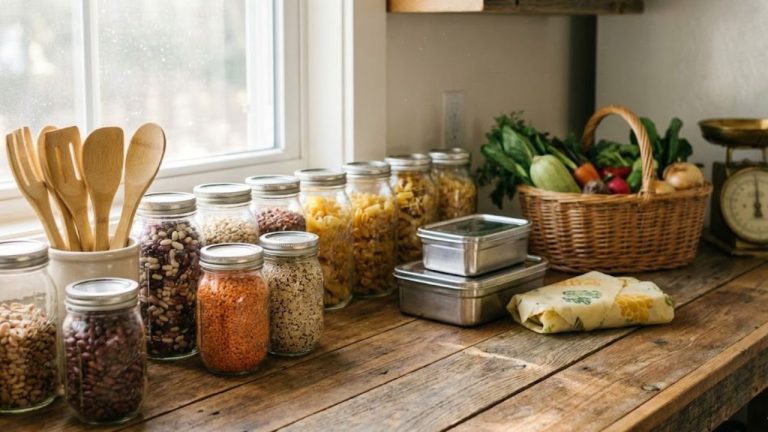Are you ready to join us on a journey towards a greener, more sustainable future? In this article, we will explore nine practical tips for recycling and upcycling that will not only benefit our environment but also save us money and spark our creativity.
Together, let’s take small steps towards reducing waste, conserving resources, and making a positive impact on our world. It’s time to transform our everyday actions into meaningful contributions and belong to a community of conscious individuals.
Environmental Impact
Recycling and upcycling have a significant environmental impact, reducing waste and conserving resources. By actively participating in these practices, we can contribute to pollution prevention and carbon footprint reduction.
Recycling involves the collection and processing of used materials such as paper, plastic, and glass, which are then transformed into new products. This process helps prevent pollution caused by the extraction and production of virgin materials.
Upcycling, on the other hand, involves repurposing discarded items to create new and useful products, reducing the need for raw materials and energy-intensive manufacturing processes.
Both recycling and upcycling play a vital role in reducing our impact on the planet. By embracing these practices, we can make a real difference and create a more sustainable future for ourselves and future generations.
Let’s work together to protect our environment and build a sense of belonging within our community.
Waste Reduction
To reduce waste, we can actively engage in practices that promote recycling and upcycling. By embracing a circular economy mindset and participating in composting initiatives, we can significantly contribute to waste reduction.
Here are three actionable steps you can take today:
- Opt for reusable products: Invest in reusable items such as water bottles, shopping bags, and coffee cups. This simple switch can eliminate the need for single-use items and reduce waste.
- Practice proper waste segregation: Separate your trash into different bins for recycling, composting, and landfill. This ensures that materials are sent to the correct facilities, minimizing waste that ends up in landfills.
- Get creative with upcycling: Instead of throwing away old items, find innovative ways to repurpose them. Upcycling can breathe new life into old objects, reducing the need for new purchases and reducing waste in the process.
Resource Conservation
By conserving our resources, we can make a significant impact on our sustainable living practices. One of the key aspects of resource conservation is energy efficiency. This means using energy in a way that minimizes waste and maximizes output. By adopting energy-efficient practices, such as using LED light bulbs, insulating our homes, and using energy-efficient appliances, we can reduce our overall energy consumption and lessen our impact on the environment.
Another important concept in resource conservation is the circular economy. This is an economic system that aims to minimize waste and maximize the use of resources by recycling, reusing, and repurposing materials. By embracing the principles of the circular economy, we can reduce our reliance on new resources and contribute to a more sustainable future.
Cost Savings
As we continue to explore the benefits of sustainable living practices, it’s important to note the significant cost savings that can be achieved through resource conservation. Embracing recycling and upcycling not only helps the environment, but it also comes with financial advantages that can make a real difference in our budgets.
Here are three ways that recycling and upcycling can be budget-friendly:
- Reduced waste disposal costs: By recycling and upcycling items instead of throwing them away, we can significantly reduce the amount of waste that ends up in landfills. This means we spend less on waste disposal fees and can allocate those funds to other areas of our budget.
- Lower shopping expenses: Instead of always buying new items, we can repurpose and upcycle what we already have. This not only saves money but also encourages us to be creative and think outside the box when it comes to our belongings.
- Energy and water savings: Recycling materials requires less energy and water compared to manufacturing new ones. By using recycled products, we can reduce our energy consumption and water usage, resulting in lower utility bills.
Creative Expression
We can further enhance our sustainable living practices and explore our creative expression through recycling and upcycling. Not only does recycling help reduce waste and conserve resources, but it also provides a platform for artistic projects and DIY crafts that can be both functional and beautiful.
By repurposing old items or materials, we can unleash our creativity and transform them into something new and unique. Whether it’s turning glass bottles into vases, or repurposing old furniture into stylish decor pieces, the possibilities are endless.
Through these creative endeavors, we not only contribute to a more sustainable future but also find joy and fulfillment in our artistic expression.
Conclusion
Let’s remember that recycling and upcycling aren’t just about reducing waste and conserving resources. They hold the power to transform our lives in ways we can’t even imagine.
Just like a caterpillar turns into a beautiful butterfly, our small efforts to recycle and upcycle can lead to a sustainable and vibrant future for generations to come.
So let’s spread our wings and embrace the magic of recycling and upcycling for a better world.




